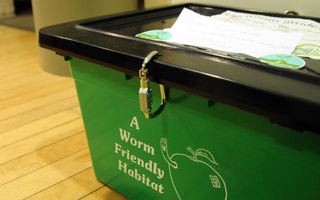Harvard has significantly reduced its greenhouse gas emissions, waste, energy, and water use since 2006, according to a new report released by the University’s Office for Sustainability on Tuesday.
The first report since the office set sustainability goals last year, the release highlights the progress the University has made in meeting its reduction targets. Ninety-eight percent of emissions at the University involve heating spaces and providing electricity in buildings, according to the report. University-wide energy use has been reduced 2 percent, when accounting for growth and renovations.
University President Drew G. Faust has pointed to research and teaching as ways that Harvard can contribute to environmental sustainability and reduce fossil fuel dependence and also emphasized sustainability initiatives on Harvard’s campus. Environmental activist group Divest Harvard, which is demanding that the University divest its endowment from fossil fuels, has prevented Faust from entering her office in Massachusetts Hall for two days this week as it carries out a planned blockade of the building.
The report emphasizes sustainable research—which Faust has consistently pointed to as a superior alternative to divestment—pointing to the 239 faculty affiliated with the Harvard Center for the Environment teaching 243 courses on energy, sustainability, or the environment. Harvard has spent $71 million funding sustainable research since 2009, according to the report.
Even while the University has grown over 3 million square feet in new construction and renovation, University-wide greenhouse gas emissions have been reduced by 21 percent since 2006, nine points below its 30 percent goal by 2016, according to the report.
Jisung Park, a climate change researcher and Eliot House tutor, said Harvard’s greenhouse gas targets are “very ambitious” compared to other universities.
“I see Harvard’s main comparative advantage on two planes: The first is pushing forward the knowledge frontier by engaging in cutting-edge research, and I think Harvard’s track record speaks for itself,” Park said. “The second is cultivating the leaders for this model because, for better or for worse, everyone is a leader at Harvard.”
Ninety-seven LEED green certified building projects have been built on Harvard’s campus—the most among any higher education institution in the world, according the report.
The University has reduced trash per capita by 27 percent between 2006 and 2014, putting it more than halfway to its 2020 goal of a 50 percent reduction. Students, faculty, and staff recycled at a rate of 51 percent in 2014, which, as along with composting, and reuse activities, contributed to the waste reduction, the report read. University-wide water use dropped by 21 percent over the same eight-year period.
“Harvard’s approach to sustainability is constantly evolving, informed by the discovery that comes from working across disciplines, across campus, and across sectors,” Heather A. Henriksen, director of the Office for Sustainability, said in a statement.
The number of Cambridge and Allston commuters who use sustainable transportation to get to work has increased steadily over the past eight years. Eighty-five percent of Longwood commuters using public transportation, rideshare, bicycle or walking. Thirteen percent of employees drove to work alone in 2014.
Last October, Harvard was named a Gold-level Bicycle Friendly University, a designation given out by the League of American Cyclists that recognizes a University’s commitment to providing both routes and incentives for biking. Harvard is the only Ivy League school to achieve gold status, a title it shares with nine other universities across the country.
The report also emphasized health and well-being standards, pointing to the University’s September decision to make Harvard Yard tobacco-free.
The report lists several initiatives that are in progress, such as establishing a baseline for organic landscaping, setting goals for e-waste management, establishing sustainable purchasing standards, and calculating the total amount of landscaped area across all its campuses.
—Staff writer Mariel A. Klein can be reached at mariel.klein@thecrimson.com. Follow her on Twitter @mariel_klein.
Read more in University News
Grad Students’ Path to Unionization May Depend on Labor BoardRecommended Articles
-
Material WorldNoted author and professor Juliet Schor talked ecology and fashion at the Harvard Bookstore last Friday. A crowd of followers
-
Numbers Please, President FaustOn March 5, the city of Boston and Harvard University co-hosted a conference titled, “Green Cities: Lessons from Boston and
-
 Harvard Celebrates Earth Day
Harvard Celebrates Earth Day -
Green Transportation Event Showcases Sustainability EffortsThe annual event aims to “let [the University community] know [about] all the stakeholders that are promoting sustainable transportation across campus,” said Ben Hammer of CommuterChoice.
-
Foodbetter Summit Stirs Discussion on SustainabilityThe Foodbetter Harvard Initiative held a cornucopia of events last week, ranging from panels with celebrity chefs to a sustainability and innovation fair, intended to promote conversations about healthy and sustainable food choices on campus.













